I’ve been out on location, painting in papers — to build a new series of collage landscapes that I shall talk more about soon!
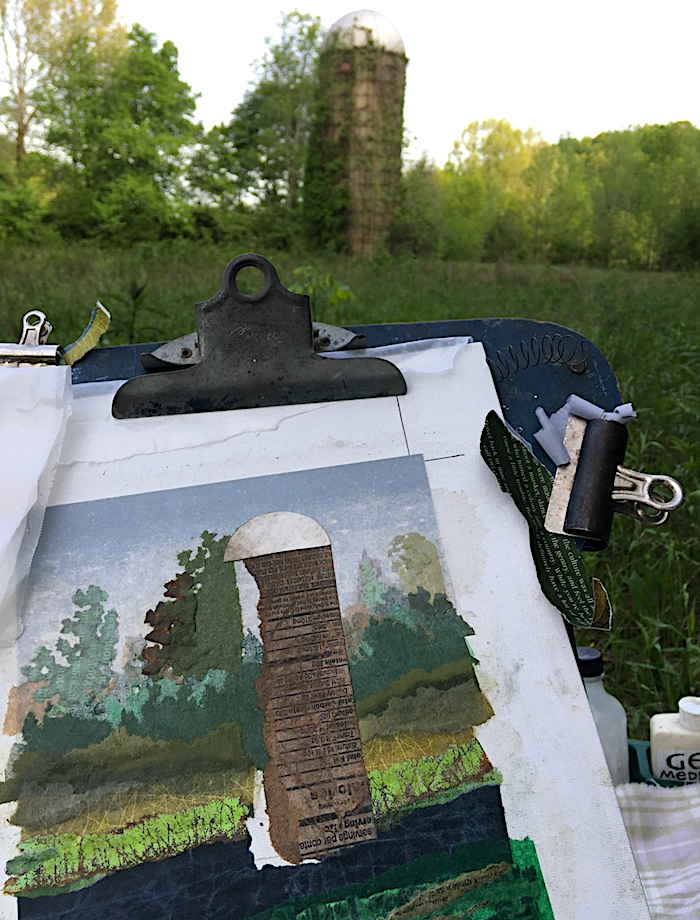
Did you celebrate World Collage Day?
Check out this Instagram tag and be amazed.
My Oh So Fallible Intuition
collage experiment by J A Dixon
6.25 x 6.6875 inches
a salute to World Collage Day, 2022
available for purchase
“Follow the ways of natural creation, the becoming, the functioning of forms, then perhaps starting from nature you will achieve formations of your own, and one day you may even become like nature yourself and start creating.”
— Paul Klee
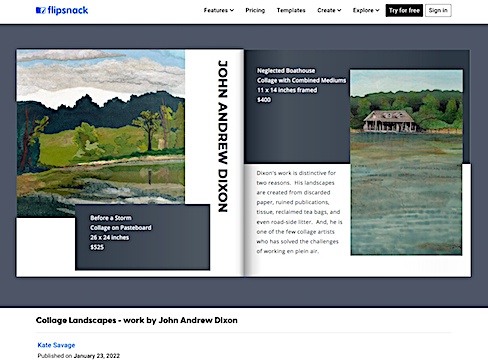 As I pushed toward the hanging date for CHANGE OF SEEN last month, I pulled out an unfinished work. In 2020 it had been my hope to complete it as part of the Paint By Nature entry — an interpretation of an urban oak tree. Everything was done except for the tree itself, which I’d wanted to paste together in a burst of spontaneity. The “start” went into cold storage when I ran out of time for two submissions. Fast forward to January 2022. Now I had the ideal scenario. My tight deadline would not allow me to indulge any slowdown or second guess. Positive, unanticipated things often happen when I occasionally challenge myself to work under a severe constraint. The hesitant, rational mind is sidelined in favor of an intuitive response that is rooted in everything one has ever created. This can be the case with music, writing, or nearly any artistic format, but the phenomenon especially lends itself to painting.
As I pushed toward the hanging date for CHANGE OF SEEN last month, I pulled out an unfinished work. In 2020 it had been my hope to complete it as part of the Paint By Nature entry — an interpretation of an urban oak tree. Everything was done except for the tree itself, which I’d wanted to paste together in a burst of spontaneity. The “start” went into cold storage when I ran out of time for two submissions. Fast forward to January 2022. Now I had the ideal scenario. My tight deadline would not allow me to indulge any slowdown or second guess. Positive, unanticipated things often happen when I occasionally challenge myself to work under a severe constraint. The hesitant, rational mind is sidelined in favor of an intuitive response that is rooted in everything one has ever created. This can be the case with music, writing, or nearly any artistic format, but the phenomenon especially lends itself to painting.
Interestingly, I’ve always preferred watercolors to other paint mediums because of its unpredictability and the “happy accidents” that occur. I admire oils greatly, but they hold no attraction for me as I approach my 70s. I hadn’t expected to discover that “painting in papers” could captivate me so and knit a reverence for nature into my art. 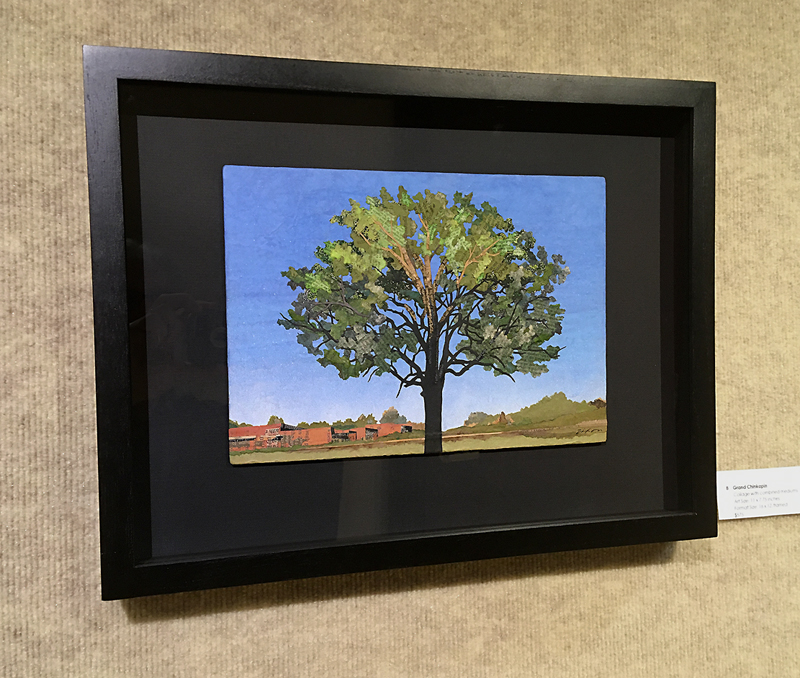
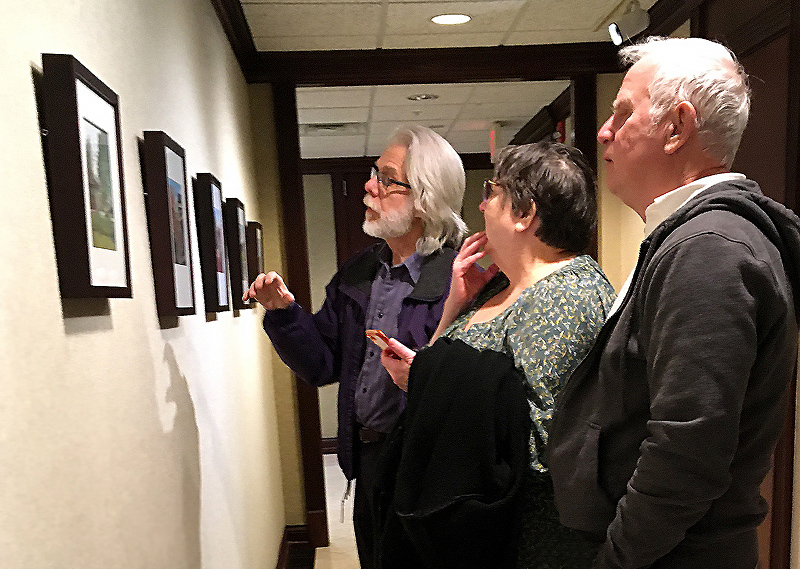 One of the primary appeals of collage is total flexibility. It’s almost impossible to make a blunder, if one stays “in the zone” without letting the intellect gain an upper hand. When others use words such as exacting or meticulous to describe what I do, it usually throws me, because I consider my approach as more instinctive. And yet, there is no denying the presence of “artisanship.” With any task at hand, craft is essential. It was drilled into me with rigor after I chose the path of applied design. (That the young are asked to dedicate themselves to a particular discipline and to ignore countless alternatives is a weird fact of life. Many of us spend decades unraveling it.) So, a certain precision is fused into my method, even when I’m racing the clock. One man’s chaos is another man’s perfectionism.
One of the primary appeals of collage is total flexibility. It’s almost impossible to make a blunder, if one stays “in the zone” without letting the intellect gain an upper hand. When others use words such as exacting or meticulous to describe what I do, it usually throws me, because I consider my approach as more instinctive. And yet, there is no denying the presence of “artisanship.” With any task at hand, craft is essential. It was drilled into me with rigor after I chose the path of applied design. (That the young are asked to dedicate themselves to a particular discipline and to ignore countless alternatives is a weird fact of life. Many of us spend decades unraveling it.) So, a certain precision is fused into my method, even when I’m racing the clock. One man’s chaos is another man’s perfectionism.
I’ve lived my adult life trying to spin creative gold in a studio of one sort or another. A supremacy of the natural world in my youth had been set aside as part of an itinerary toward the graphic arts profession. Reflecting on a long journey that leads to the ever-rolling “now,” I recognize that nature was always calling. It influenced my leaving big cities for a smaller community. It provided a firm foundation for my diet and a health-oriented lifestyle. It was an unfailing source for well-being when conditions seemed out of balance. Even so, an unsatisfied need remained elusive until I finally took paper and paste outdoors, where the potential for inspiration was out of arm’s reach. That I could respond with collage, and find it so rewarding, is something I hadn’t foreseen.
If you want to start with the first chapter, you can find that story here. It’s been almost five years of direct observation, and I’m itching to begin a new season of working en plein air. The broader point I’d like to make is how the experience also has invigorated the way I approach representational collage in the studio. It feels like it’s all been funneled into an evolving intuition. Working outside has transformed how I make visual decisions even when using photographic reference under pressure, as I did with Grand Chinkapin. After quickly preparing piles of printed scrap that seemed appropriate for tree foliage, I was able to explode those ingredients into place with a minimum of conscious thought — not unlike I try to do every time I take my collage kit on location. “Painting from nature with paper” has become a more integrated practice, inside or outside. Change of Seen shares this adventure with others.
Grand Chinkapin
collage with combined mediums by J A Dixon
0% / 100% — site to studio
11 x 7.75 inches + shadow-box frame
available for purchase
“The most important thing
a painter can do is find
a good place to sit.”
— J.E.H. MacDonald
I started this miniature on location in 2019, deep into a hollow that reveals a natural site which offered the only large amount of “refrigeration” available to Kentucky pioneers in the region. My vision for a final look required more indoor time than could ever meet a qualification for en plein air. Paper can be a stern schoolmaster in the studio at times, and I’ve been known to get prickly under his tutelage, but Mother Nature smiles when I “return home.”
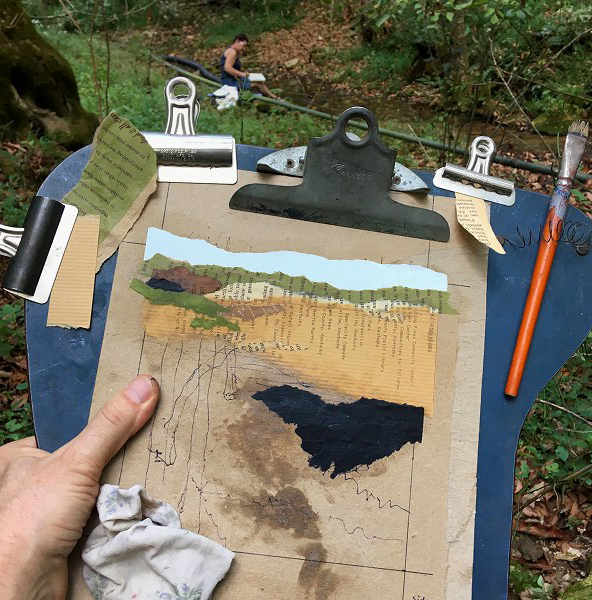
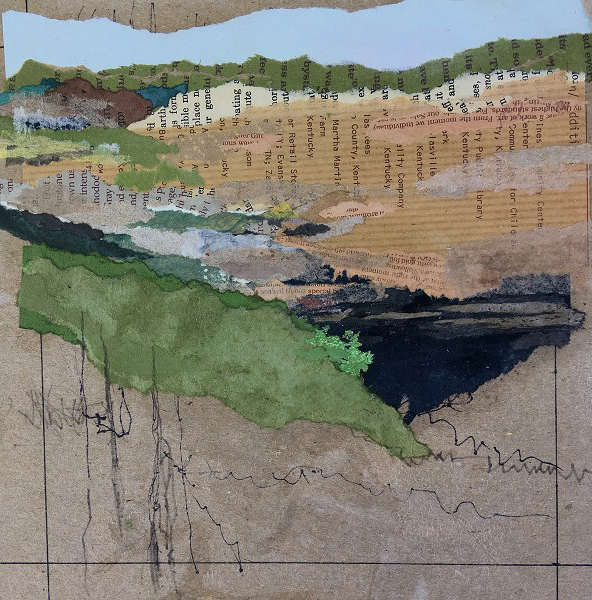
(above, left) A collage ‘start’ in the woods taking shape on my clipboard.
(above, right) The completed location work fell short of a finished landscape.
Cave Spring
collage miniature by J A Dixon
started on location / finished indoors
7.25 x 7.5 inches
• S O L D
“We think of the things we own and use as defining us in some way, but that can only be true if we first describe the things. Describing is a remarkable human act. It connects our inner and outer experience: as we observe and record the material world, we respond and reflect. We enter the realm where the material world meets the imagination. That’s the fertile ground of art.”
– Sheldon Tapley
I created this artwork for The Object Seen: Contemporary Still Life, current exhibition at Art Center of the Bluegrass in Danville. The juror was Sheldon Tapley, masterful painter, draftsman, and Stodghill Professor of Art at Centre College. I received a 2nd-place ribbon and cash prize. 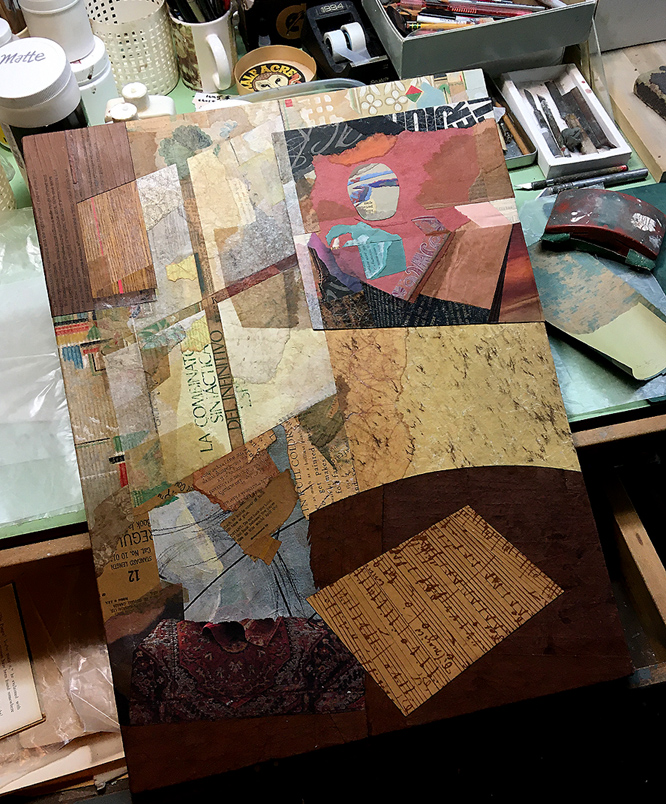 The honor came as a surprise, since I don’t consider myself a practitioner or student of still life as an art form. I have, however, looked deeply at artwork made by Sheldon and those who are. The arms-length quality of modern still life has compelled my close scrutiny for many years. Given that influence, I brought to the genre what I’ve discovered by “painting in papers” from direct observation (the long sweep of art history hovering somewhere outside my conscious awareness, with its rich tradition of artists tackling visual cornacopias of objects and edible fare). I decided to interpret a tabletop group of objects from raw material, rather than assemble a conventional collage composition from found images.
The honor came as a surprise, since I don’t consider myself a practitioner or student of still life as an art form. I have, however, looked deeply at artwork made by Sheldon and those who are. The arms-length quality of modern still life has compelled my close scrutiny for many years. Given that influence, I brought to the genre what I’ve discovered by “painting in papers” from direct observation (the long sweep of art history hovering somewhere outside my conscious awareness, with its rich tradition of artists tackling visual cornacopias of objects and edible fare). I decided to interpret a tabletop group of objects from raw material, rather than assemble a conventional collage composition from found images.
Please view a video clip of the juror’s remarks about my artwork.
The peony tulip blossoms were created en plein air in a local flower garden. The small “still life within a still life” was commenced and partially finished from a setup of actual objects. I relied on photo reference for the rest. Ingredients include colored paper (printed and unprinted), wallpaper, ruined book parts, tissue, reclaimed tea bags, string, and a dried leaf, plus minimal use of walnut juice, burnt coffee, tinted paste, and marker-ink edging. Adhesives include wheat paste, acrylic matte medium, and white glue.
Still Life with Peony Tulips
collage on salvaged canvas
18 x 23.75 inches
• Second Place Prize
“If everything seems under control, you’re just not going fast enough.”
— Mario Andretti
One week ago, I spent a windy Saturday in frantic competition with the clock, and managed to get an outdoor collage artwork framed and delivered for Lexington’s annual Paint the Town plein air event. At the opening reception that same evening, I was stunned to get a prompt sale and 2nd-place prize. It was one of the most exhilarating twelve hours I’ve experienced in quite a while.
Oh, the dubious lengths some of us will go to chase artistic intensity — even the temporary madness of extreme deadline pressure — all in the pursuit of rapt spontaneity. Heaven help me!
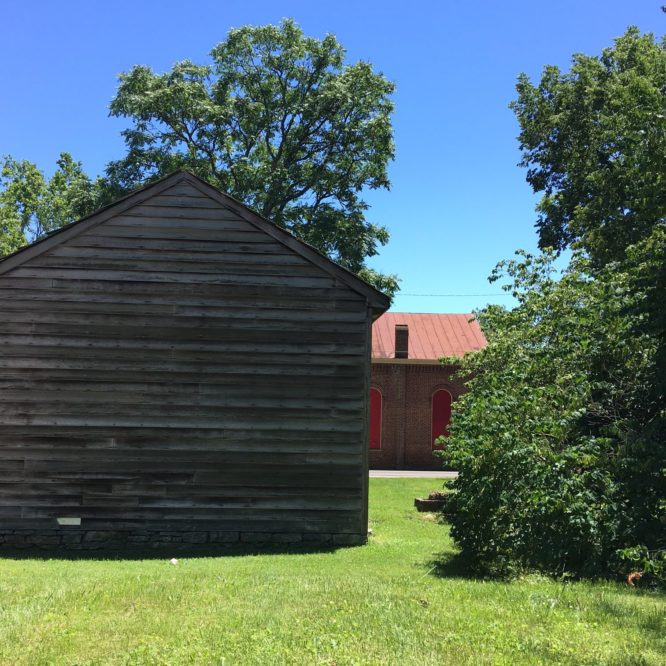
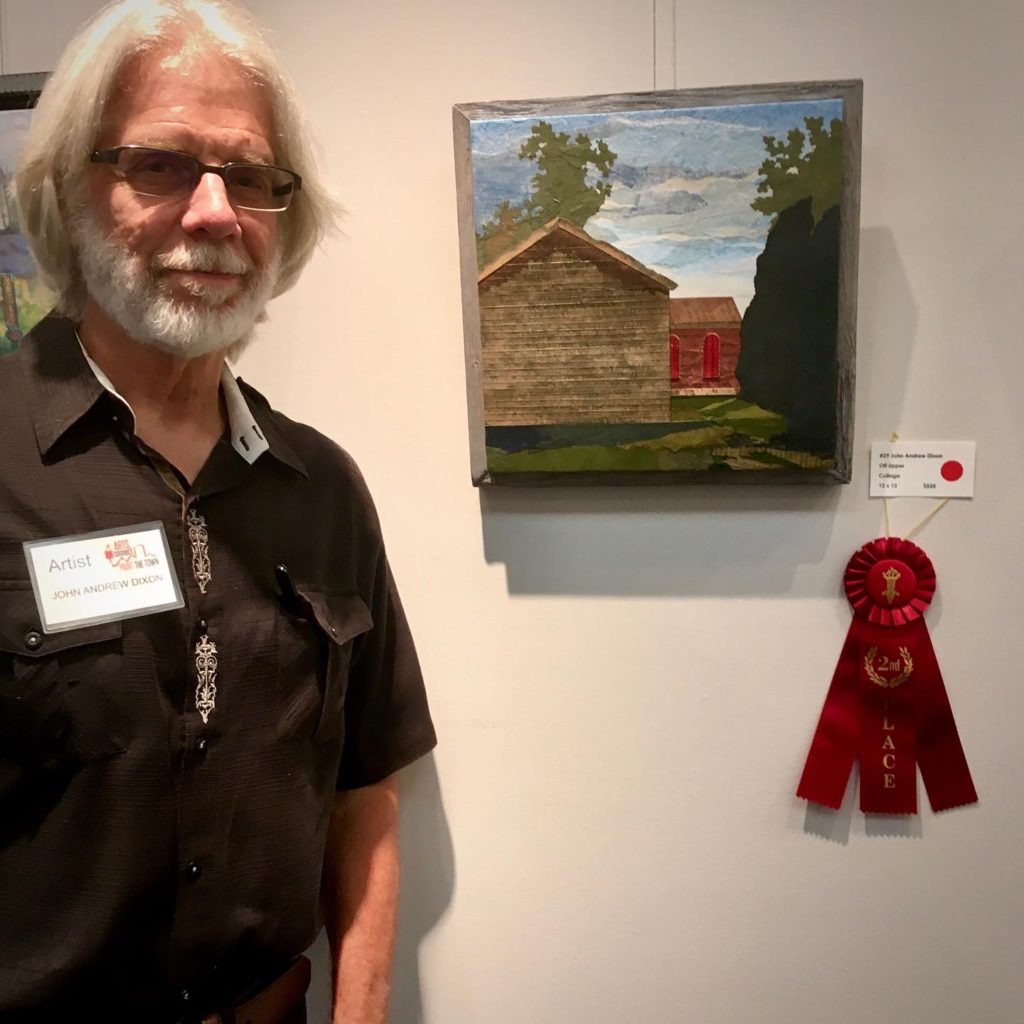 It doesn’t seem so long ago when I first took my collage obsession out of doors, and this kind of open challenge was a goal too absurd to contemplate. I had scouted the location and spent a couple days in preparation. By the time I’d registered a blank canvas, raced to my site and set up, one of the precious six hours had evaporated. I began to battle the breeze (nothing new there). Nor were the other 40 artists involved my foes. It was clear that the only towering opponent I faced was a daunting imperative to speed up my process. I’ve never pasted paper so fast in my life!
It doesn’t seem so long ago when I first took my collage obsession out of doors, and this kind of open challenge was a goal too absurd to contemplate. I had scouted the location and spent a couple days in preparation. By the time I’d registered a blank canvas, raced to my site and set up, one of the precious six hours had evaporated. I began to battle the breeze (nothing new there). Nor were the other 40 artists involved my foes. It was clear that the only towering opponent I faced was a daunting imperative to speed up my process. I’ve never pasted paper so fast in my life!
The judge said this about my piece: “I was very interested in the way this artist managed to create such an evocative landscape using collaged paper — and on a windy day! Places and buildings often hold so many memories and meanings, and the use of text on the siding of the buildings — with the words appearing in reverse, so they become texture and tone — adds another level of meaning.”
It’s gratifying, and profoundly reinforcing, to have a knowledgeable evaluator find significance in aspects that have evolved gradually to become a natural part of my plein air method. I appreciate her remarks, the organizing effort of all those with Arts Connect, the camaraderie of the participating artists, the buyers (Scott and Paul), the indispensable support of my dearest partner — and you, reader, for visiting here and for reading all of this!
Onward to the next challenge!
Off Upper
plein air collage on canvas by J A Dixon
12 x 12 inches + handmade frame
• Second Place Prize / S O L D
This artwork was created for and accepted into BEGINNINGS/ENDINGS, a virtual exhibition organized by Kate Savage at Arts Connect in Lexington, Kentucky. It began with musings on the cyclic lives of trees as a resource. Searching my stash for collage ingredients prompted what I consider a spontaneous work of abstraction as much as an interpretation of the exhibition theme.
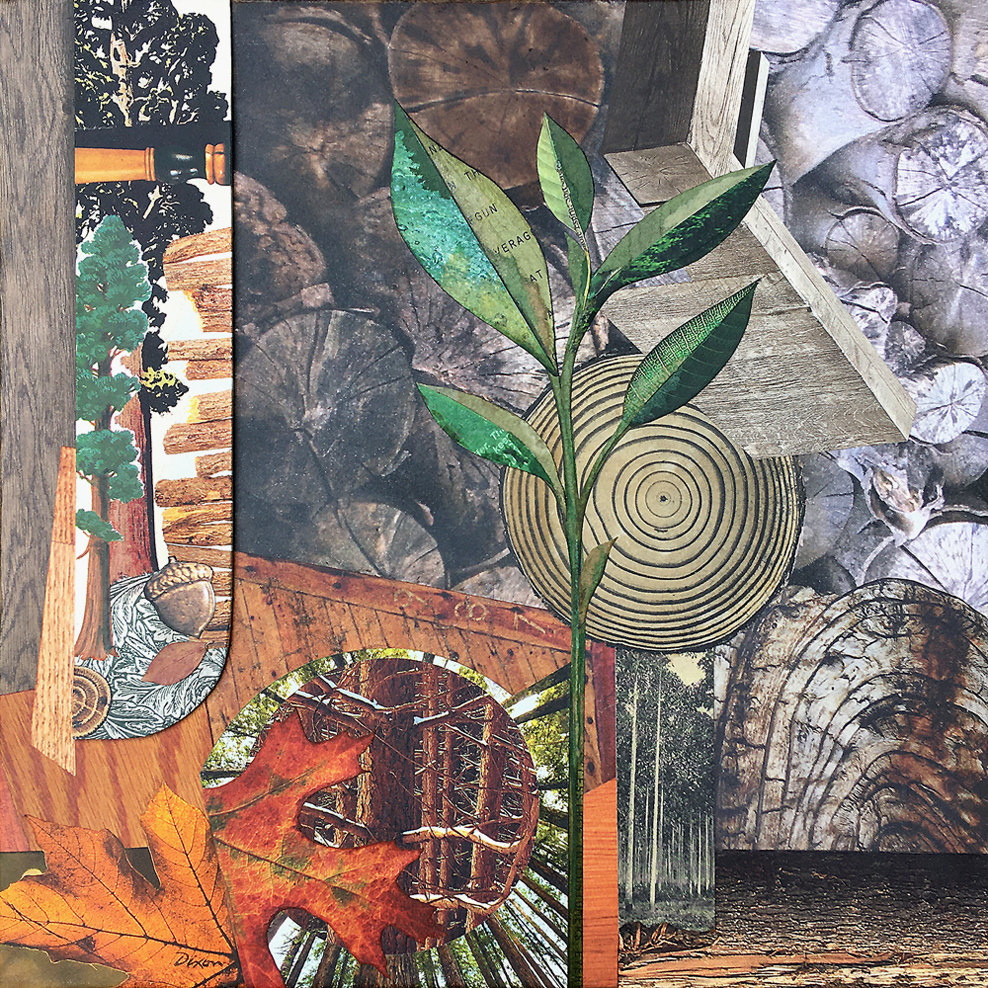
Renewal
collage on canvas by J A Dixon
12 x 12 x 1.25 inches
available for purchase
“Younger than we are,
O children, and frailer,
Soon in the blue air they’ll be,
Singer and sailor.”
— Nest Eggs | A Child’s Garden of Verses,
Robert Louis Stevenson, 1900
Today is the final day of “New Birth, New Growth, New Beginnings,” a juried exhibition celebrating spring at Art Center of the Bluegrass. My accepted artwork originated from a satisfying blend of subject, medium, and poetic reference.
The green space that surrounds my home studio has been a haven for multiple generations of robins. A surreptitious, close-up glimpse of their familiar nest eggs was the visual idea that dislodged any others I might have used to interpret the theme. Spring is my favorite time of year, as it is for many, and perhaps the finished piece captures how my imagination is charged with anticipation for nature’s annual season of renewal. There is also something about the chaotic order of a bird’s nest that ideally lends itself to collage ingredients. I wanted to include the textural patterns of printed text, along with actual organic substance — in this case, the inner membranes of hard-neck garlic stalks from the previous year’s harvest. The “patina” of salvaged wallpaper from a nearby historical tear-down provided areas of desired subtlety. Relying on reclaimed tea-bag material has gradually become an integral part of my technique, but I hadn’t put it to use before with such a linear quality. For zones that would benefit from deeper shadow, I added walnut juice to my typical polymer sealant and “smoothed” the eggshells ever so slightly with colored pencil and a milky tint (giving rise to the final description of “combined mediums”).
Human civilization has increasingly peeled itself from the balanced interdependence of the natural world. More of us are doing our best as individuals to fix that torn relationship. There are different ways to promote a necessary restoration. It’s important to discover as many as possible. I find myself taking more advantage of bringing art to nature and nature to art. I am thankful that my life conditions grant me creative opportunities to experience this healing process.
Soon in the Blue Air They’ll Be
collage with combined mediums on structured panel
J A Dixon, 20 x 25 inches
• S O L D
“Perpetual devotion to what a man calls his business is only to be sustained by perpetual neglect of many other things.”
— Robert Louis Stevenson
ROCK, PAPER, SCISSORS, the virtual exhibition organized by Kate Savage at Arts Connect, had its online event with artist commentary yesterday. 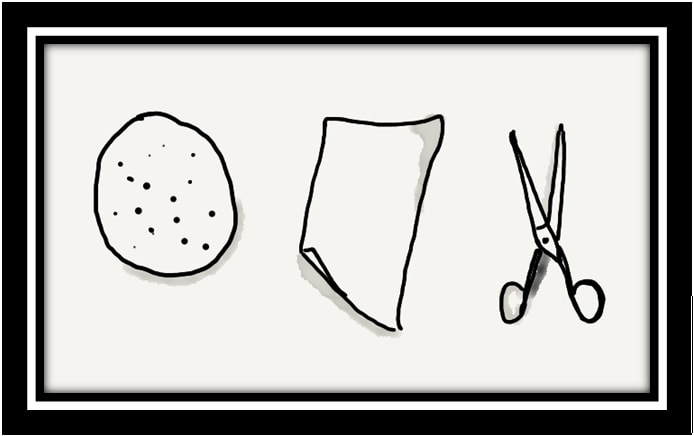 As I prepared some remarks about my included artwork, I looked back to see what I’d written about it after its completion in 2019.
As I prepared some remarks about my included artwork, I looked back to see what I’d written about it after its completion in 2019.
Nothing — that’s what I found.
With an emphasis on documenting my journey into making collage en plein air, I’ve apparently neglected to say as much about a corresponding investigation of studio-based landscape. Being a self-taught illustrator and fine artist, working from photographs has been a central part of the creative process — at least since my days as a “gopher” student in the 1970s, when I assisted veteran commercial artists compile reference scrap for tight-deadline assignments. In recent years, my work on location is informing how I do a collage painting indoors from a photo.
Quarry is a fitting example, created from a wonderful image by Jeff Hiles, an Ohio photographer who generously gave a green light to interpret his work in another medium. My piece also dovetails nicely with the theme of the show. More importantly, it demonstrates how I’m gradually learning to bring into the studio the sense of immediacy and intuitive spontaneity that I experience when working directly from a natural scene.
Quarry
collage landscape by J A Dixon
25 x 18.5 inches
on panel, framed
available for purchase